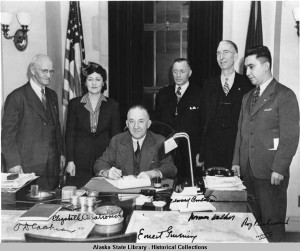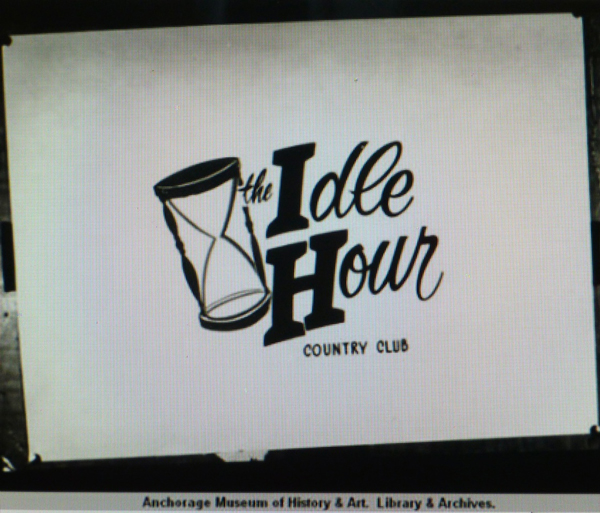“ The past is never dead, it’s not even past.” William Faulkner
It’s been years since I was at The Idle Hour, an upscale supper club that began life in 1938 with white tablecloths and floor to ceiling windows that overlooked spectacular sunsets and the silvery Lake Spenard. In that romantic setting, I had an almost proposal over lobster and prime rib that left me with fond, if embarrassed, memories.
By 1971, when I left Anchorage, The Idle Hour had been destroyed by fire a couple of times, reputedly for the insurance. In 1970 it reappeared as the Fancy Moose and in 1978, the Flying Machine. In 1980 it incarnated as the Fly By Night Club.

During The Idle Hour’s early days and following WWII, Alaska’s cafes, restaurants, bars and nightclubs posted signs forbidding entrance to Natives and Filipinos. In 1945, Tlingit Indian, Elizabeth Peratrovich eloquently reminded Alaska’s Territorial Legislature House of Representatives of the Bill of Rights that prohibited racial discrimination. Her message was heatedly contested as unnecessary. The House took another view, however, when a general at Fort Richardson declared the military off limits to Anchorage if those were the kinds of signs they had. The signs were removed.
On my infrequent trips to Anchorage, I have tried and failed to find where The Idle Hour had once stood. I couldn’t even find Lake Spenard. So I started asking relatives and former Anchorage High School classmates what they remembered. Judy Mueller Jett thought it had been where the present Millennium Hotel is on Lake Hood. That confused me. I remembered The Idle Hour on Lake Spenard. Judy replied that in the early seventies two deep channels were cut, connecting Lake Spenard with Lake Hood to accommodate a rapidly growing number of small aircraft – a major source of transportation in Alaska. The west end, she explained, is Lake Hood and the east end is Lake Spenard: Ah, one lake with two names.
When she mentioned swimming there as a girl, I recalled the overcast sky and freezing water, kids shrieking over giant black leaches, wooden picnic tables, skinny hot dogs, tart yellow mustard and buns gritty with sand, and even my baggy swimsuit worn under a sweater. I was five years old and couldn’t swim, but that day I was Esther Williams.
Jesse Bell recalled that the parents of another classmate had danced the Lindy Hop at The Idle Hour in the 1950’s, “causing a sensation.” Erryl and his father of Brown’s Music Store had delivered a piano there. Others celebrated birthdays, engagements, graduations and other special occasions at the supper club. One friend had gone there as a girl with her parents to get a free kitten.
In a recent obituary, I learned Miss Wiggles – a showily limber African American entertainer – performed there in the late sixties and mid-seventies. Jana Nelson recalled seeing tall, blond Christine Jorgenson, the first known transsexual, on The Idle Hour’s stage in 1963. “She sang and talked, answering questions. The place was packed and the show was quite good…”
As for the club’s owners, Mike Gordon thought Jimmy Sumpter might have once owned it. This is a reasonable speculation. In those years, Sumpter owned and operated, among others, two local topless/strip clubs including The Kit Kat and The Sportsman Too. He was a colorful character and on the periphery of — if not directly involved in — a couple of homicides. His connection to these and other questionable dealings appear in true crime stories by Tom Brennan, Kim Rich and Mike Gordon.
In 1984, the former Idle Hour was (legally) demolished to make way for The Millennium Hotel. With a nod to the surrounding aviation, including a busy international airport and two of the site’s former hot spots, the hotel named their pub, The Fancy Moose and their restaurant, The Flying Machine. Their website describes the pub as on Lake Hood, while the restaurant – in the same building — overlooks Lake Spenard.
Ten or so years ago, when I was in Anchorage, I met my uncle Don for breakfast at a local diner. He was my last living Harper uncle: half Athabascan, the youngest of my grandmother’s ten children. He had grown up in Fairbanks, a shady little town, if there ever was one. In Don’s time, Fairbanks was smaller and everyone knew everything that happened: from which prominent daughter or wife was having a third abortion to which father, brother, son, boyfriend or neighbor was hiding out, and how a local family had been startled to find bags of cash stuffed under the potatoes in their root cellar.
The diner had a no smoking section, but someone’s cigarette wafted our way and I moved closer to the window, inhaling the cold fresh draft. I was working on a novel and asked Don what he knew about crime in Fairbanks. Specifically arson. He settled back in the booth and twirled his coffee cup. “Guys came up from Anchorage,” he said, “and practiced setting fires. They’d burn shacks and houses and trailers out near the airport and on the road from Anchorage.”
My eyebrows shot up. “The police didn’t care?” (I said “police”, but until statehood in 1959, U.S. Marshals assisted the local police and were THE presence for criminal activity outside local jurisdictions. After statehood, Alaska State Troopers replaced the Marshals.)
“They looked the other way,” Don said with a shrug. Ah, favors being done and money exchanged, I thought. “Certain ones you stayed away from,” he added. “They hated Natives. They’d pull you over, walking along or in a car, didn’t matter, and beat you up.”
“Why?” I hated this.
He shook his head. “No reason needed.”
I let this settle then said, “Was anyone killed in these practice fires in Fairbanks?” I was pretty sure no one had died in The Idle Hour fires — which had led some to feel better about the arsonists, being so careful and all.
Don shook his head he didn’t think so. His expression, however, left me unsure.
Later, I wondered if The Idle Hour’s arsonists had “practiced” in Fairbanks? And had they been part of The Company, a motley group of Anchorage criminals who attempted to organize after the manner of the mafia? Their first president was John Rich, later murdered at the behest of two other members. Not off to a great start, I’d have thought.
My lingering romantic images of The Idle Hour and Anchorage have taken a beating. The seedy underside of my hometown is not dramatic or picturesque like a noir movie. It is alarming, tacky and ugly. I mean arson? Murder? Come on, crappy people do that. And what about those who lined their pockets and looked the other way?
Still, taking a deep breath, I remind myself that every town has its underside. Not that that makes it right, mind you. I’m just being philosophical here.
Recently, I came across The Inheritance of Loss, by Kiran Desai, who wrote, “The present changes the past. Looking back, you do not find what you left behind.”
Jan (Petri) Harper Haines was born in Sitka, Alaska and is Athabascan, Irish and Russian. In 1990 she began gathering the stories told by her mother and grandmother about their lives on the Yukon. Her book "Cold River Spirits" grew out of these early stories. Jan’s short stories have appeared in literary publications and magazines. She is a graduate of Anchorage High School (West), and earned a bachelor’s degree from the University of Alaska-Fairbanks. She is a former secondary education teacher, and had a twenty-year career in advertising and marketing.
Jan lives in Marin County, California with her husband, and often visits Alaska.





